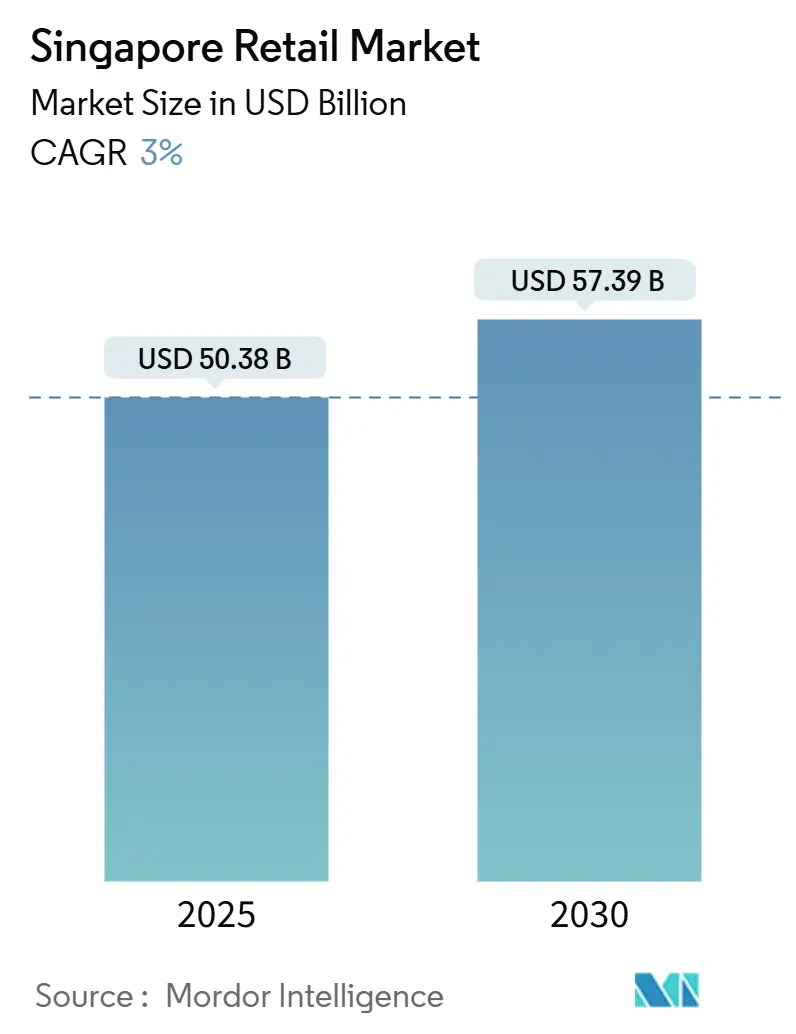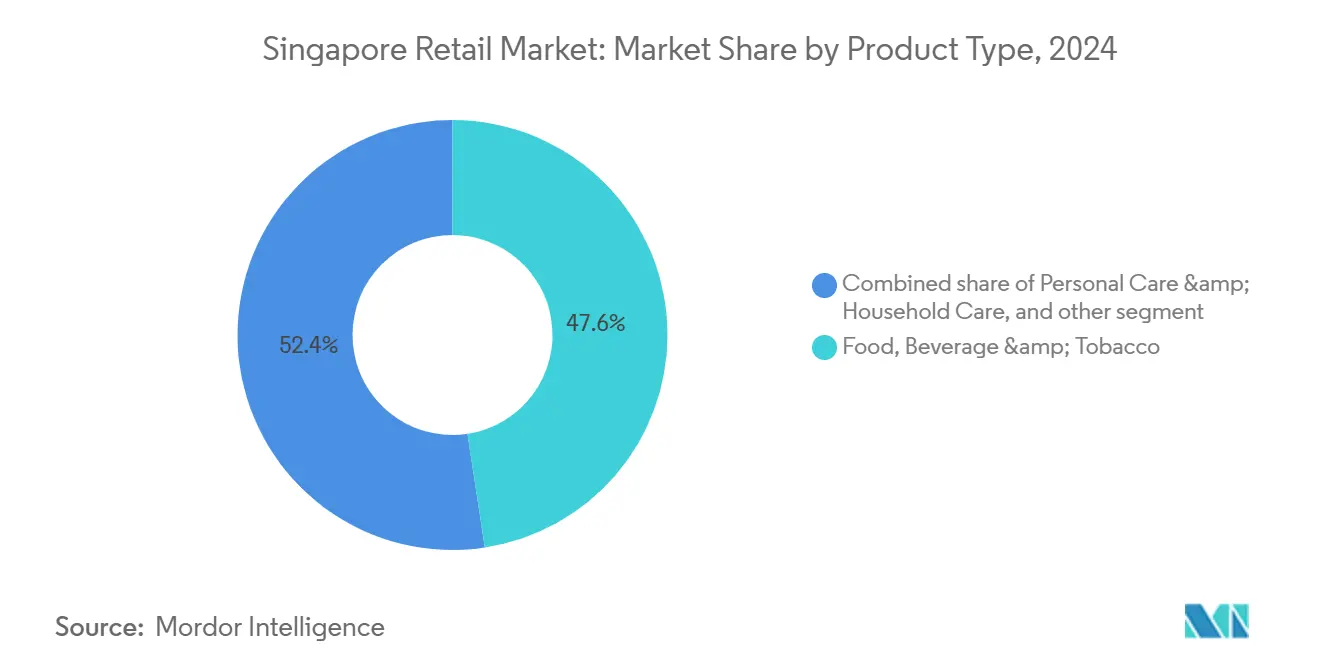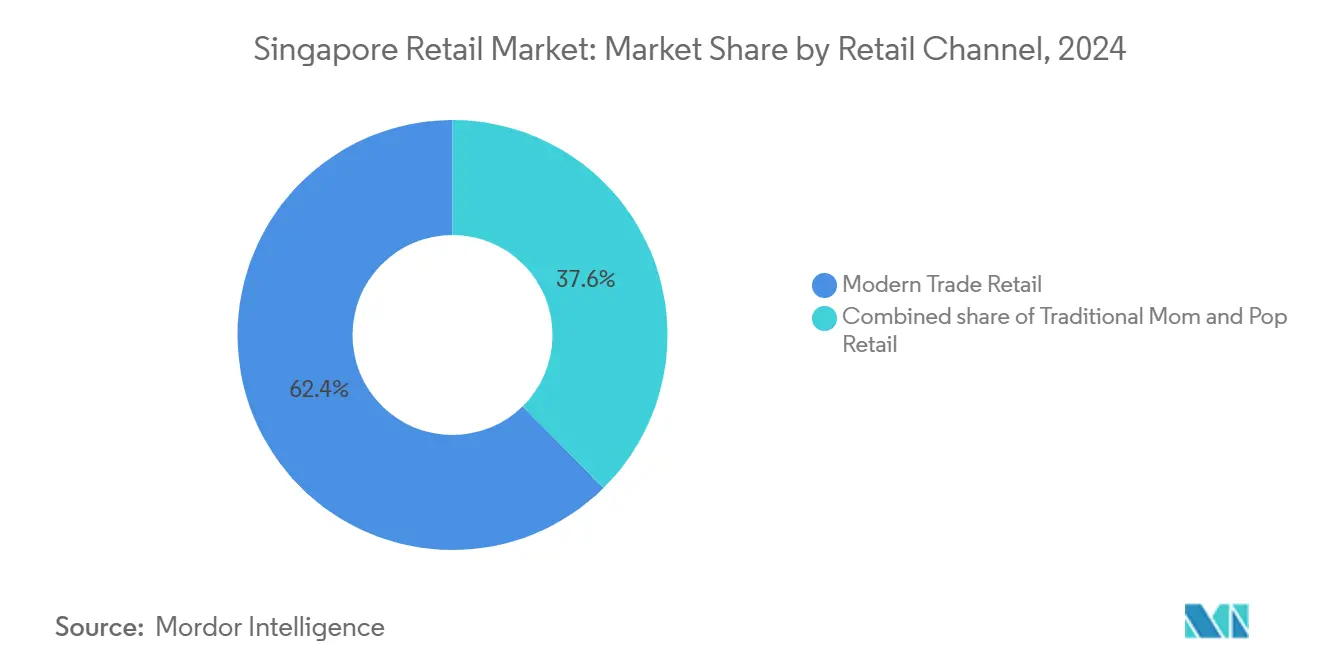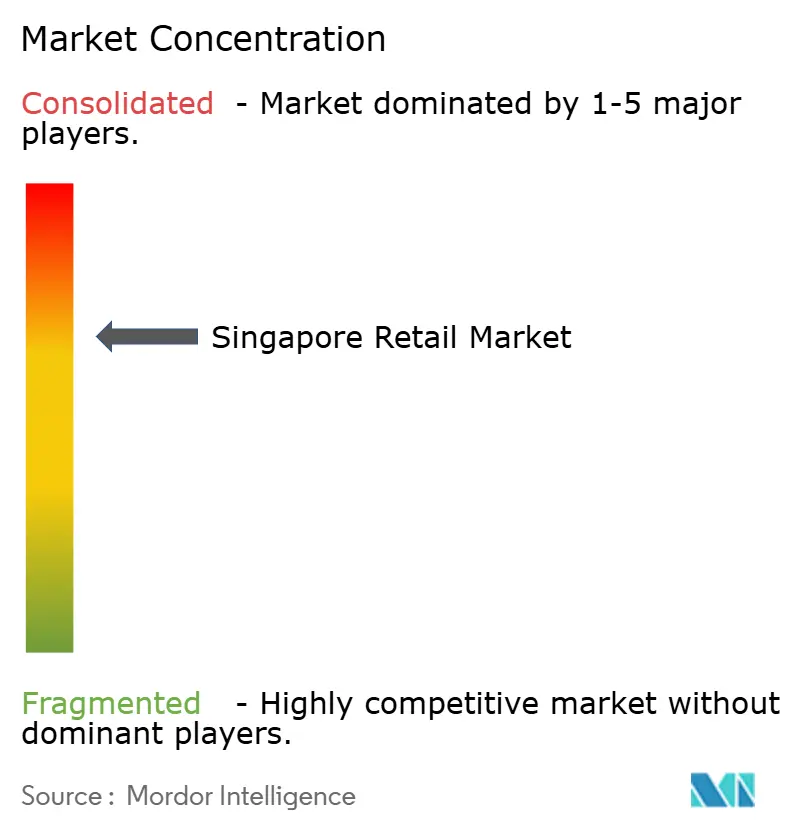
Singapore Retail Market Analysis by Mordor Intelligence
The Singapore retail market size stands at USD 50.38 billion in 2025 and is forecast to reach USD 57.39 billion by 2030, reflecting a 2.64% CAGR that underlines the sector’s steady evolution rather than rapid expansion [1]U.S. Department of Commerce, “Singapore Retail Sector,” trade.gov. . Rising discretionary spending from 16.5 million tourists in 2024 together with record receipts of SGD 29.8 billion (USD 22.1 billion) adds vital momentum to the Singapore retail market. Structural headwinds from a saturated mall pipeline and labor-cost inflation temper growth, yet omnichannel innovation and ESG-linked financing continue to unlock productivity gains that keep margins resilient. Competitive intensity remains elevated as FairPrice, Sheng Siong, DFI Retail Group, Shopee, and Lazada collectively hold 78% of the Singapore retail market, prompting firms to double down on private-label development, logistics optimization, and data analytics. The tourism-led demand surge, coupled with sustained residential consumption, positions the Singapore retail market to capture incremental value through experiential concepts that blur digital and physical boundaries.
Key Report Takeaways
- By product type, food, beverage, & tobacco led with 47.62% of the Singapore retail market share of the singapore retail market in 2024, while personal care & household are expanding at an 8.17% CAGR through 2030.
- By retail channel, modern trade held 62.38% of the Singapore retail market share in 2024, whereas e-commerce & others posted the fastest 12.28% CAGR to 2030.
- By format, supermarkets accounted for 40.33% of the Singapore retail market share in 2024, and convenience stores are advancing at a 9.88% CAGR over the same period.
Singapore Retail Market Trends and Insights
Drivers Impact Analysis
| Driver | (~) % Impact on CAGR Forecast | Geographic Relevance | Impact Timeline |
|---|---|---|---|
| Rising omnichannel consumer journey adoption | +0.8% | National, early gains in Central Region | Medium term (2-4 years) |
| Expansion of supermarket private-label penetration | +0.6% | National, concentrated in heartland areas | Long term (≥ 4 years) |
| Tourism rebound boosting discretionary spend | +0.5% | Central Region, Orchard Road corridor | Short term (≤ 2 years) |
| ESG-linked financing lowering capex for retrofit | +0.3% | National, prime commercial districts | Medium term (2-4 years) |
| Real-time retail analytics via 5G edge networks | +0.2% | Central Region, suburban malls | Long term (≥ 4 years) |
| Urban logistics micro-hub policy roll-out | +0.1% | National, high-density zones | Medium term (2-4 years) |
| Source: Mordor Intelligence | |||
Rising Omnichannel Consumer Journey Adoption
Singaporean shoppers increasingly demand seamless movement between online and in-store pathways, prompting retailers to unify inventory, payments, and loyalty programs across channels; 95% of grocery shoppers purchased house brands in 2024, highlighting growing comfort with digitally influenced decisions. The Singapore retail market therefore witnesses substantial capital outlay toward enterprise resource planning upgrades that combine real-time product visibility with same-day fulfillment. FairPrice’s mobile app, which integrates promotions, e-payments, and rewards, underscores the sector’s pivot to data-driven engagement that raises average basket sizes. E-commerce penetration, now touching 30%, places the Singapore retail market on par with regional digital leaders and forces legacy grocers to adopt marketplace partnerships for incremental reach. Younger Gen Z cohorts amplify the shift by rewarding brands that deliver curated, personalized journeys across social media, web, and store environments. Retailers successfully orchestrating omnichannel experiences report productivity gains between 15% and 25% through faster turnover and lower markdowns, reinforcing the driver’s medium-term influence on revenue quality.
Expansion of Supermarket Private-Label Penetration
Private-label portfolios help retailers widen margins in a market pressed by rising costs, and FairPrice’s house brands generated nearly SGD 1 billion (USD 730 million) in 2024, equal to 20% of its topline. The Singapore retail market therefore benefits from wider assortment depth, with over 3,500 private-label SKUs that compete head-on with multinational brands yet carry higher gross margins. Nielsen tracking shows 33% of consumers increased private-label purchases since 2021, citing improved quality parity and sharpened price points, thereby encouraging allegiance to supermarket ecosystems. Retailers channel savings from direct sourcing into loyalty perks, deepening customer stickiness that buffers against promotional battles. Strategies that blend vertically integrated manufacturing with transparent sustainability narratives further strengthen brand equity. As FairPrice targets 30% private-label penetration, competitors accelerate their own programs, creating a long-term driver that boosts profitability across the Singapore retail market.
ESG-Linked Financing Lowering Capex for Retrofit
The Monetary Authority of Singapore’s Sustainable Loan Grant Scheme subsidizes up to SGD 100,000 (USD 73,000) per green loan, reducing capital costs for retrofitting stores with LED lighting, energy-smart HVAC, and zero-waste packaging [2]Monetary Authority of Singapore, “Sustainable Loan Grant Scheme,” mas.gov.sg.. Under the Enterprise Financing Scheme – Green, eligible firms can secure SGD 50 million (USD 36.5 million ) with 20-year tenors, creating a competitive funding landscape that accelerates eco-projects [3]Enterprise Singapore, “Enterprise Financing Scheme – Green,” enterprisesg.gov.sg. . Early adopters report retrofit bills shrinking 20%–30% versus conventional borrowing, freeing cash for omnichannel technology. ESG adherence simultaneously enhances corporate reputation and resonates with Gen Z, who prioritize environmental credentials when selecting retailers. The Singapore retail market therefore integrates sustainability into core business models rather than peripheral initiatives. As frameworks mature, lenders are expected to tighten criteria, encouraging even deeper operational restructuring and cementing this driver’s medium-term impact.
Tourism Rebound Boosting Discretionary Spend
International arrivals climbed to 16.5 million in 2024, with receipts reaching SGD 29.8 billion (USD 22.1 billion) and directly stimulating fashion, luxury, and food-service categories within the Singapore retail market. Chinese, Indonesian, and Indian tourists collectively enhance premium product turnover, while the average stay lengthened to 3.8 days, extending shopping windows. Orchard Road retailers recorded double-digit sales lifts during key holidays, reaffirming the importance of tourist footfall in driving high-margin SKU movement. The Singapore Tourism Board forecasts 17–18.5 million visitors in 2025, ensuring that short-term tailwinds persist. Government allocations of SGD 300 million (USD 219 million) for new attractions, plus MICE upgrades, will further entice affluent travelers and diversify spending across regional malls. The continued tourism uptick elevates the Singapore retail market’s exposure to macro-travel cycles but remains a clear catalyst through 2026.
Restraints Impact Analysis
| Restraint | (~) % Impact on CAGR Forecast | Geographic Relevance | Impact Timeline |
|---|---|---|---|
| Saturated mall density and limited new retail space | -0.4% | Central Region, prime commercial districts | Long term (≥ 4 years) |
| Labour shortages & rising minimum-wage floor | -0.3% | National, acute in service-intensive formats | Short term (≤ 2 years) |
| High rental costs in core urban areas | -0.5% | Orchard Road, CBD, and key commercial hubs | Medium term (2–4 years) |
| Growing shift to e-commerce impacting footfall | -0.6% | National, with sharper urban/suburban divide | Medium term (2–4 years) |
| Source: Mordor Intelligence | |||
Saturated Mall Density and Limited New Retail Space
Prime vacancy below 6% in core districts forces retailers to bid aggressively for scarce units, pushing rents toward 30%–50% of revenue for some tenants. The Singapore retail market thus experiences a two-tier environment where flagship high-street space commands premiums that only the largest brands can afford, while secondary sites struggle to attract traffic. Recent retail-space prices rose 1.2% in 2023 after sliding 7.8% in 2022, signaling landlord pricing power is returning. Over 3,000 F&B outlets shuttered during the past three years, amplifying attention on occupancy cost reform. Although government incentives aim to rejuvenate Orchard Road, complex strata ownership and lengthy approvals slow supply infusions. Tenant associations call for mandates that penalize prolonged vacancies and impose rental transparency, but legislative traction remains slow. This restraint is expected to weigh on long-term growth as physical network expansion becomes capital prohibitive for mid-tier chains.
Labor Shortages & Rising Minimum-Wage Floor
The Progressive Wage Model lifted minimum monthly retail salaries from SGD 1,850 (USD 1,369) in 2022 to SGD 2,175 (USD 1,588) in 2024, and mandates annual 8.4%–8.5% hikes through 2025 [4]Ministry of Manpower, “Progressive Wage Model for Retail Sector,” mom.gov.sg. . Labor constitutes up to 25% of operating costs, so fast-rising wages compress margins in service-intensive formats that already face rental pressure. Employers receive temporary offsets under the Progressive Wage Credit Scheme, yet co-funding diminishes year-by-year, forcing retailers to fast-track automation such as self-checkout and robotics. Domestic labor supply remains tight because younger workers gravitate toward digital roles, and foreign-worker quotas restrict hiring flexibility. Workforce Skills Qualification mandates add training overhead, stretching small enterprise budgets. If efficiency gains lag wage escalation, profitability in the Singapore retail market could erode further, making this restraint acute over the next two years.
Segment Analysis
By Product Type: Diverse Food Basket Anchors Growth Ambitions
Food, Beverage & Tobacco held 47.62% of 2024 revenue, demonstrating its role as the stable backbone of the Singapore retail market size and underlining consumer preference for reliable pantry staples. Personal Care & Household care products, although contributing a smaller base, deliver the fastest 8.17% CAGR through 2030, supported by post-pandemic wellness priorities and an aging demographic that values health-oriented formulations. Electronics & Household Appliances notch a 12.8% share as smart-home adoption accelerates, while Apparel, Footwear & Accessories regain momentum via tourism inflows and renewed social engagements. Premium and organic ranges proliferate as supermarkets enhance cold-chain capabilities to safeguard freshness and raise ticket sizes. Cross-merchandising accelerates as retailers design in-store journeys that combine ready-to-eat meals, on-premise cafés, and wellness corners to amplify dwell time. Manufacturers collaborate with grocers on exclusive pack sizes that fit Singapore’s compact living spaces, reinforcing segment resilience. Franchise operators adopt AI-enabled planograms that adjust stock depth daily, ensuring assortment alignment with diverse neighborhood profiles. Supply-side shocks remain minimal due to Singapore’s robust import diversification strategy, which cushions price volatility across key food categories.
The trajectory of the personal care category symbolizes lifestyle upgrading beyond mere necessities, with derma-cosmetics and eco-friendly detergents gaining shelf prominence. Category managers in the Singapore retail market deploy data analytics to pinpoint micro-segments that favor cruelty-free or halal-certified lines, allowing precision marketing that maximizes shelf productivity. Electronics retailers pivot toward subscription-based device bundles that smooth income streams and lock in consumers seeking affordable access to the latest phones or home gadgets. Fashion retailers experiment with limited-edition collaborations that create scarcity value and attract social-media amplification, effectively blurring boundaries between retail and entertainment. Furniture, Toys & Hobby, plus Industrial & Automotive, remain niche yet profitable via click-and-collect and showrooming strategies that utilize small footprints but high conversion rates. The inclusion of experiential pop-ups, such as gaming zones or chef demonstrations, keeps foot traffic energized across all product aisles, reinforcing holistic store appeal.

Note: Segment shares of all individual segments available upon report purchase
By Retail Channel: Modern Trade Scale Meets Digital Disruption
Modern Trade controlled 62.38% of turnover in 2024, anchored by large supermarket chains whose supply-chain sophistication delivers price stability and breadth that local neighborhoods trust. Meanwhile, E-Commerce & Others outpaces peers with a 12.28% CAGR to 2030, reflecting consumers’ migration toward mobile-first ordering that provides rapid price discovery and doorstep convenience. Traditional Mom & Pop outlets retain a 10.8% slice through personalized customer rapport and geographical proximity within Housing Development Board estates, though tightening labor regulations challenge their resilience. Supermarket groups expand marketplace models within their apps, allowing third-party sellers to plug into traffic flows and enrich assortment without capital-heavy inventory risk. The Singapore retail market therefore fosters hybrid ecosystems where click-and-collect counters inside modern trade stores support online pure plays while driving incremental in-store purchases. Payment innovations like Buy-Now-Pay-Later increase conversion, yet regulators monitor debt exposure closely to prevent consumer overstretch. Retail media networks emerge as powerful profit centers, monetizing onsite traffic by selling banner placements and sponsored search slots to consumer-goods brands eager for precision reach.
Sea Limited’s Shopee platform reached USD 4.95 billion in Q4 2024 revenue and projects 20% GMV growth in 2025, validating profitability potential in a once cash-burning e-commerce landscape. Lazada’s tie-up with Alibaba’s global fulfillment further compresses delivery lead times, intensifying rivalry. Modern trade operators respond by bundling grocery and ready-to-eat meals into subscription passes that encourage monthly autopay enrollment and lower churn. Social-commerce live streaming accelerates SKU velocity, with micro-influencers hosting virtual tours inside physical stores, converting viewers into immediate buyers. Clicks-to-bricks strategies include pop-up collection kiosks at transport hubs, elevating brand visibility while reducing last-mile costs. Public-sector initiatives such as parcel locker grids provide a neutral logistics backbone that levels the playing field for smaller merchants, encouraging channel diversity within the Singapore retail market.

Note: Segment shares of all individual segments available upon report purchase
By Format: Supermarkets Anchor While Convenience Stores Accelerate
Supermarkets captured 40.33% of 2024 sales owing to dense networks that align with Singapore’s compact urban footprint, robust fresh-food sections, and loyalty programs that reward frequent basket replenishment. Convenience Stores, however, grow at 9.88% CAGR to 2030 by satisfying round-the-clock demand for immediate consumption items, prepaid services, and parcel pick-ups, thus capitalizing on time-pressed lifestyles. Hypermarkets and Department Stores remain stable but require store-within-store concepts and localized product curation to sustain relevance. Specialty Stores in cosmetics, pets, and home organization harness domain expertise to charge premium prices, while the Others format category, including drugstores and cash-and-carry outlets, captures professional buyers and niche segments. The Singapore retail market experiences shrinking average store sizes as retailers chase rental efficiencies, but state-of-the-art planograms squeeze higher revenue per square foot by leveraging category adjacencies that nudge impulse buys. Mobile point-of-sale systems streamline queuing, transforming staff roles from cashiers to consultative hosts.
The aggressive rollout of 7-Eleven outlets under DFI Retail Group’s stewardship highlights appetite for compact stores that pivot quickly to changing trends, such as ready-to-eat Korean fare or limited-edition collectibles. Disposal bag levies mandated by the National Environment Agency nudge shoppers toward reusable carriers, and smaller convenience formats capitalize by selling tote bags and return-reuse packages. Supermarkets experiment with micro-fulfillment robotics that assemble online orders in dark-store zones, shortening delivery windows to two hours. Department Stores pivot toward curated showrooms for native digital brands seeking physical expression, thereby generating concession income streams without inventory risk. Hypermarkets inject experiential zones such as indoor farming exhibits and cooking studios to re-energize journeys and extend dwell time. Similar initiatives sustain the adaptability that characterizes the Singapore retail market.
Competitive Landscape
The Singapore retail market is moderately concentrated, with a small group of dominant players controlling most of the industry revenue. This concentration enables them to achieve significant scale advantages in procurement, logistics, and technology, creating high entry barriers for emerging brands. FairPrice leads the market, supported by its cooperative structure, widespread presence in residential areas, and strong private-label offering. Sheng Siong follows closely, known for its tight cost management and localized product selection that appeals to budget-conscious shoppers. DFI Retail Group maintains a broad market presence through its premium Cold Storage stores and more accessible Giant outlets, effectively targeting various customer segments. Meanwhile, digital players like Shopee and Lazada are reshaping the competitive landscape by driving price transparency and fostering frequent user engagement through gamified features, flash sales, and integrated digital wallets. Competitive playbooks reveal intensified investment in data science teams that predict demand, localize pricing, and personalize marketing to retain wallet share in the Singapore retail market.
Strategic moves in 2024–2025 underscore a pivot toward ecosystem integration. FairPrice collaborates with ride-hailers to offer two-hour grocery delivery at scale, while Sheng Siong pilots cloud-kitchen partnerships to transform under-utilized back-of-house areas into revenue-generating delivery hubs. DFI Retail Group divests noncore operations and redirects capital toward convenience-store expansion where labor savings from frictionless checkout prove compelling. Shopee introduces cross-border premium boutiques featuring authenticated luxury items, targeting tourist traffic that now shops via mobile even while visiting flagship stores. Lazada partners with parcel-locker operators to cut last-mile costs by 23% and unlock sustainability gains. Industry incumbents engage in selective M&A, exemplified by Macrovalue’s planned SGD 125 million (USD 91.25 million) purchase of Cold Storage and Giant chains, expecting synergies in sourcing and store network rationalization.
Technology adoption remains the decisive differentiator. Computer vision for automated inventory checks slashes shrinkage, while generative AI chatbots manage pre-sale queries and upsell higher-margin items. Blockchain pilots enhance supply-chain transparency for premium seafood and specialty meats, aligning with Singapore’s Food Agency traceability mandates. Concurrently, retailers integrate carbon-footprint dashboards that quantify emissions per SKU, allowing conscious consumers to select lower-impact products and reinforcing brand trust. Partnerships with fintech startups yield embedded micro-insurance and installment credit that augment transaction sizes. As competitive forces intensify, strategic focus converges on customer lifetime value over pure transaction volume, marking a maturation phase in the Singapore retail market.
Singapore Retail Industry Leaders
-
FairPrice Group
-
Sheng Siong Group
-
DFI Retail Group (Giant & Cold Storage)
-
Shopee (Sea Ltd)
-
Lazada (Alibaba)
- *Disclaimer: Major Players sorted in no particular order

Recent Industry Developments
- June 2025: Monetary Authority of Singapore extended SGD 15 million (USD 10.95 million) Sustainable Loan Grant Scheme through 2028 to encourage green retail retrofits
- March 2025: Cold Storage and Giant chains agreed to be acquired by Malaysian group Macrovalue for SGD 125 million (USD 91.25 million); deal closing expected H2 2025.
- March 2025: Sea Limited posted record Q4 revenue of USD 4.95 billion and forecast 20% GMV growth for Shopee in 2025.
- February 2025: FairPrice house brands generated close to SGD 1 billion (USD 730 million) in 2024 sales across 3,500 products in 70 categories.
Singapore Retail Market Report Scope
The report on the Singapore retail sector provides a comprehensive evaluation of the market, with an analysis of the segments in the market. The Singapore Retail Sector is segmented by Products into Food and Beverages, Personal and Household Care, Apparel, Footwear and Accessories, Furniture, Toys and Hobby, Electronic and Household Appliances, and Other Products. By Distribution Channel, the market is segmented into Hypermarkets, Supermarkets and Convenience Stores, Specialty Stores, Department Stores, E-commerce, and Other Distribution Channels. The report offers market size and forecasts for the Singapore retail sector in Value (USD million) for all the above segments.
| Food, Beverage, & Tobacco Products |
| Personal Care & Household Care |
| Apparel, Footwear, & Accessories |
| Furniture, Toys, & Hobby |
| Industrial & Automotive |
| Electronic & Household Appliances |
| Other Products |
| Traditional Mom & Pop Retail |
| Modern Trade Retail |
| E-Commerce & Others |
| Hypermarkets |
| Supermarkets |
| Convenience Stores |
| Department Stores |
| Specialty Stores |
| Others (Drugstore, Cash & Carry, Wholesaler) |
| By Product Type | Food, Beverage, & Tobacco Products |
| Personal Care & Household Care | |
| Apparel, Footwear, & Accessories | |
| Furniture, Toys, & Hobby | |
| Industrial & Automotive | |
| Electronic & Household Appliances | |
| Other Products | |
| By Retail Channel | Traditional Mom & Pop Retail |
| Modern Trade Retail | |
| E-Commerce & Others | |
| By Format | Hypermarkets |
| Supermarkets | |
| Convenience Stores | |
| Department Stores | |
| Specialty Stores | |
| Others (Drugstore, Cash & Carry, Wholesaler) |
Key Questions Answered in the Report
What is the projected value of the Singapore retail market in 2030?
It is expected to reach USD 57.39 billion by 2030, supported by a 2.64% CAGR.
Which product segment grows fastest through 2030?
Personal Care & Household products expand at an 8.17% CAGR, outpacing all other categories.
How large is e-commerce within Singapore’s retail channels?
E-Commerce & Others posts the quickest 12.28% CAGR, challenging modern trade dominance.
E-Commerce & Others posts the quickest 12.28% CAGR, challenging modern trade dominance.
Convenience Stores grow at a 9.88% CAGR due to 24-hour accessibility and parcel-pickup services.
Convenience Stores grow at a 9.88% CAGR due to 24-hour accessibility and parcel-pickup services.
The top five players command 78% of revenue, indicating a high but not absolute concentration.
What financing incentives support green store renovations?
The Sustainable Loan Grant Scheme covers up to SGD 100,000 (USD 73,000) per eligible loan, reducing retrofit costs for retailers.
Page last updated on:



